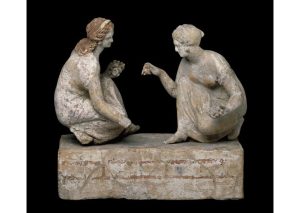In ancient Greece, the game of “Astragaloi” held a unique place as a popular and culturally significant pastime. The term “Astragaloi” refers to a game played with knucklebones, small, typically ankle bones from sheep or goats, or similar small objects resembling dice. This game not only served as a source of entertainment but also offered a glimpse into the daily life and leisure activities of the ancient Greeks.
Archaeologists have uncovered the links to this ancient game made in far of locations from Greek such as at Maresha-Bet Guvrin National Park, location in the Judean Shefelah, Israel in 2022. The excavations found that the game is prevalent as back as 300 BC.
Also read: Gambling in India during Mughal era
The gameplay involved throwing these knucklebones, and the scoring was determined by the way they landed. Variations of the game existed, with one notable version utilizing five knucklebones. In this variant, players would throw the bones, and the scoring system would be based on the positions in which the knucklebones landed. The intricacies of the rules could vary, adding an element of strategy and skill to the game.

The popularity of Astragaloi extended beyond mere amusement; it became an integral part of social gatherings and festivals. Whether played in the agora, the central public space of ancient Greek cities, or during private gatherings, the game brought people together, fostering camaraderie and community spirit.
Moreover, Astragaloi held cultural significance, reflecting the values and norms of ancient Greek society. The game was not just about chance; it required a degree of skill and dexterity, offering players an opportunity to showcase their abilities. As a result, Astragaloi became a symbol of athleticism and prowess, aligning with the Greeks’ admiration for physical and mental excellence.
The symbolism of Astragaloi extended into various aspects of Greek culture, including art and literature. The game was depicted on pottery and in murals, showcasing its ubiquity in everyday life. Additionally, references to Astragaloi can be found in ancient Greek literature, further emphasizing its cultural relevance.
In conclusion, Astragaloi stood as more than a simple game in ancient Greece. It was a nuanced activity that entertained, connected people, and reflected the values of a society that celebrated both skill and chance. As we explore the annals of history, the game of Astragaloi stands as a testament to the multifaceted nature of leisure activities in shaping the cultural tapestry of ancient civilizations.
Feature image credit: Sculpture of a girl playing astragaloi. Wikimedia Commons



